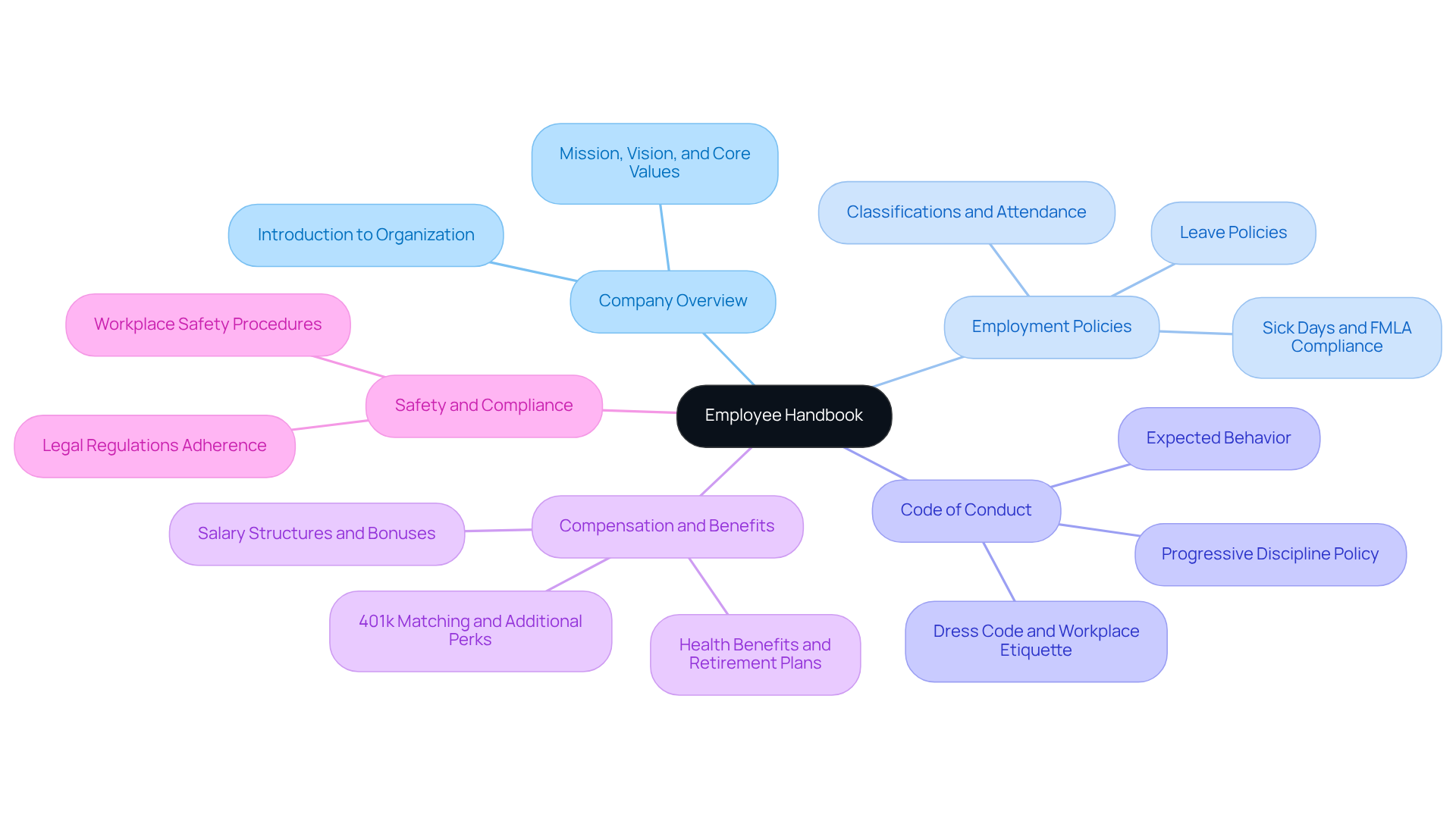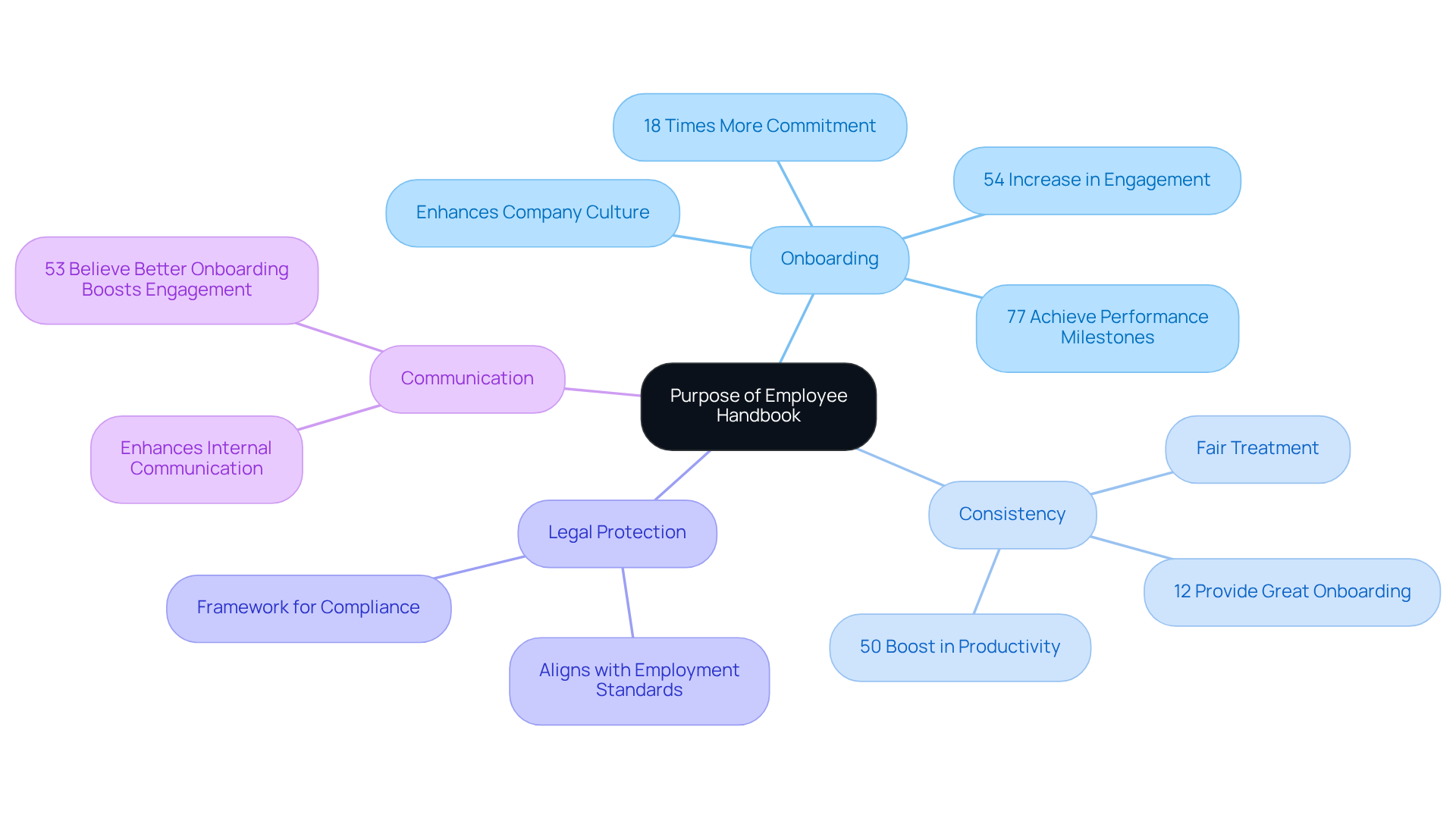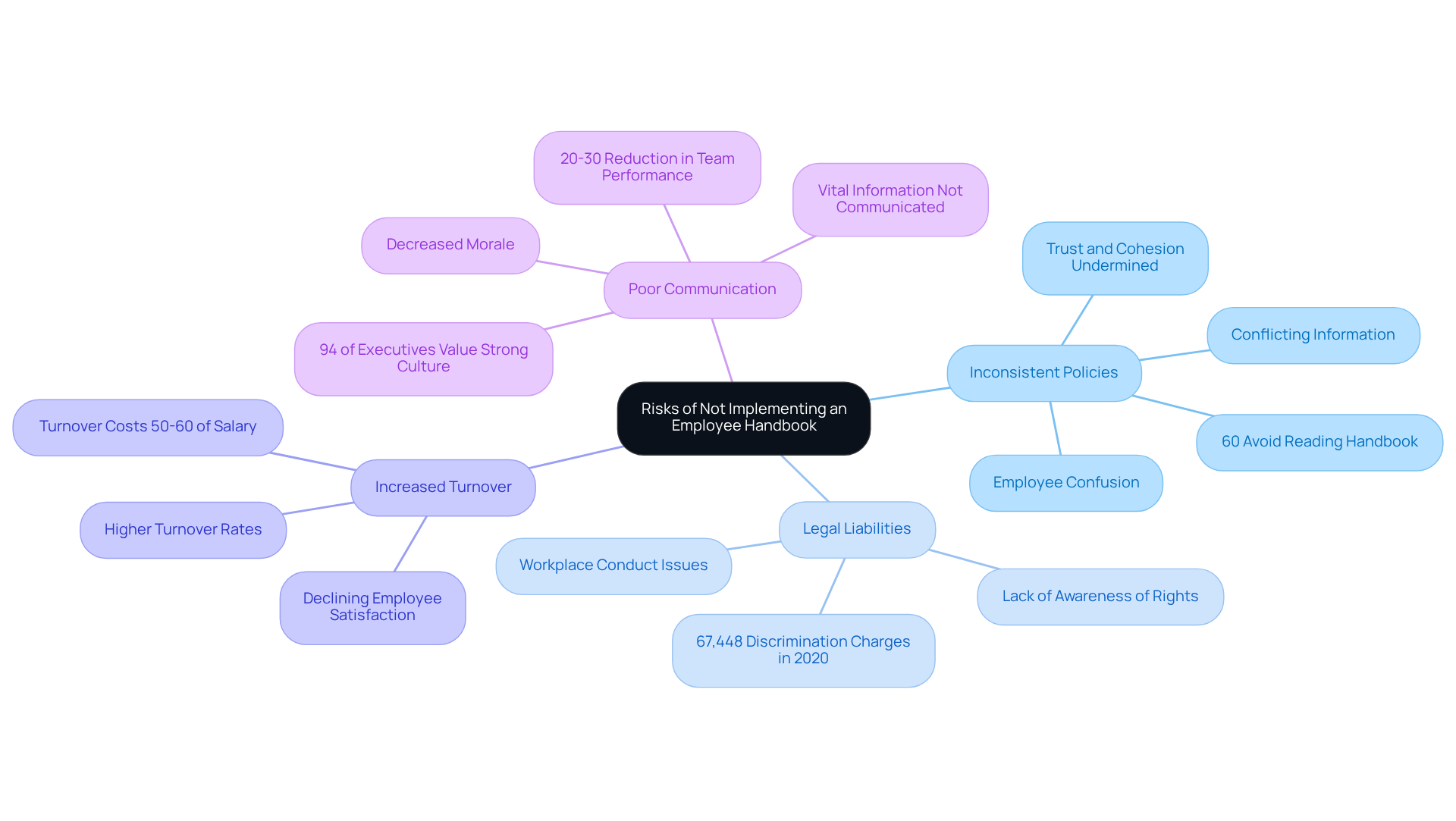
Overview
You might be wondering what the purpose of an employee handbook is for operations managers. Well, it’s really about being a go-to resource that lays out an organization’s policies, procedures, and expectations. This not only promotes transparency but also helps everyone stay compliant with employment laws.
Now, let’s dive into why a well-structured handbook is a game changer. It can:
- Boost company culture
- Ensure everyone is treated consistently
- Provide legal protection
- Support effective communication
All of these factors are crucial for keeping operations running smoothly and engaging your employees. So, isn’t it time to think about how your handbook can make a difference?
Key Highlights:
- An employee handbook serves as a vital resource outlining an organisation's policies, procedures, and expectations.
- Key components of a handbook include Company Overview, Employment Policies, Code of Conduct, Compensation and Benefits, and Safety and Compliance.
- A well-designed handbook can enhance company culture, improve onboarding processes, and attract top talent.
- The handbook promotes consistency in treatment of employees, reducing misunderstandings and increasing productivity.
- Legal protection is provided through clear communication of policies, helping organisations avoid potential legal issues.
- Neglecting to implement a handbook can lead to inconsistent policies, legal liabilities, increased turnover, and poor communication.
- Best practises for developing a handbook include engaging employees, using clear language, regular updates, ensuring accessibility, and conducting training sessions.
Introduction
You might be wondering, what role does an effective employee handbook play in shaping an organization's culture? Well, it’s pretty much the backbone, laying out the essential policies and expectations that guide team members.
For operations managers, understanding this crucial document isn’t just about ticking boxes for compliance; it’s about tapping into the potential for better employee engagement and smoother operations.
But what if this vital resource is missing? The risks can be pretty significant—think inconsistent policies and higher turnover rates.
So, how can organizations make sure their handbook isn’t just there but actually makes an impact?
Define Employee Handbook: Essential Components and Structure
You might be wondering what an employee guide, or employee manual, really is. Well, the purpose of the employee handbook is to serve as an essential resource that lays out your organization’s policies, procedures, and expectations for everyone on the team. The employee handbook purpose is to promote transparency and help everyone stay compliant with employment laws, which is super important as we head into 2025 with new labor regulations popping up.
Let’s break down the key components you can expect to find in a solid employee guide. First up is the Company Overview. This section gives you a quick intro to the organization, outlining its mission, vision, and core values—these are crucial for building a strong company culture. Then we have Employment Policies. Here, you’ll find clear guidelines on classifications, attendance, and leave policies, all designed to set expectations and keep things consistent across the board.
Next, let’s talk about the Code of Conduct. This part outlines the expected behavior for staff members, including dress code and workplace etiquette—essential for maintaining that professional vibe. Moving on to Compensation and Benefits, you’ll find detailed info on salary structures, bonuses, health benefits, and retirement plans, all of which are vital for keeping everyone satisfied and sticking around.
Now, don’t forget about Safety and Compliance. This section covers the procedures to ensure a safe work environment and adherence to legal regulations—especially important as organizations face more scrutiny regarding workplace safety.
The layout of your guide should be clear and systematic, making it easy for staff to navigate through the information. Did you know that organizations with well-designed staff manuals are one-third more likely to experience growth? That really highlights how important these manuals are for fostering success! Plus, the employee handbook purpose can be a fantastic recruitment tool, giving potential candidates a glimpse into your company culture and policies, which helps attract top talent.
In fact, a whopping 83% of staff members believe that having an onboarding program in place would be beneficial. This really emphasizes the connection between organized guides and efficient onboarding processes. For operations managers, a structured staff manual isn’t just a formality; it’s a strategic resource that boosts operational efficiency and worker engagement.
And let’s not overlook the importance of incorporating measures for sick days and following the Family and Medical Leave Act (FMLA) if you have 50 or more staff members. Finally, it’s a good idea for staff members to sign a document confirming they’ve reviewed the manual—this ensures everyone understands and adheres to the guidelines. So, what do you think? Ready to dive into creating or refining your employee guide?

Explain the Purpose of an Employee Handbook: Importance for Business Success
You might be wondering what the employee handbook purpose is. Well, the employee handbook purpose is to be a go-to reference for your team, laying out the organization’s policies and expectations. This document is super important for a few reasons:
- Onboarding: It helps new hires get a feel for the company culture and understand their roles. Did you know that businesses that invest in thorough orientation programs see a whopping 54% rise in staff engagement? Plus, folks who receive effective training feel 18 times more dedicated to their organization.
- Consistency: A solid manual makes sure everyone is treated fairly and consistently, cutting down on misunderstandings. Organizations with standardized induction processes enjoy a 50% boost in productivity, yet only 12% of them offer an excellent induction experience. That’s a big gap in effective practices!
- Legal Protection: It provides a framework that helps shield the organization from potential legal issues by clearly outlining policies and procedures. Keeping these policies in line with modern employment standards is key for growth and staying compliant with employment laws.
- Communication: A good manual enhances internal communication by clearly outlining important company info and updates, supporting a positive work environment. Studies reveal that 53% of HR specialists believe that better orientation boosts worker involvement, which underscores the manual's role in fostering a nurturing atmosphere.
In summary, the employee handbook purpose goes beyond onboarding; it’s a game-changer for overall business success. It fosters consistency, offers legal protection, and paves the way for effective communication. Remember, 'Onboarding doesn’t just influence how a new hire begins; it also influences how long they stay.' That really highlights the long-term impact of effective onboarding practices.

Discuss Consequences of Absence: Risks of Not Implementing an Employee Handbook
You might be wondering what the employee handbook purpose is and why it is so crucial. Well, neglecting to implement one can really expose organizations to some significant risks. Let’s break it down:
-
First off, we have inconsistent policies. Without a standardized handbook, conflicting information can pop up regarding company policies. This can lead to confusion and dissatisfaction among employees, which is never a good thing. When staff feel uncertain about their rights and responsibilities, it can undermine trust and cohesion within teams. Did you know that 60% of staff avoid reading their company handbook? That can really exacerbate misunderstandings!
-
Next, let’s talk about legal liabilities. Organizations can face some serious legal challenges when employees aren’t aware of their rights and responsibilities—especially concerning workplace conduct and safety regulations. For instance, in 2020, the Equal Employment Opportunity Commission reported over 67,000 discrimination charges. This highlights just how important it is to communicate clearly about worker rights to avoid potential legal repercussions.
-
Now, increased turnover is another biggie. When policies aren’t clear, dissatisfaction can creep in, leading to higher turnover rates. Research shows that turnover costs can reach up to 50-60% of a worker’s annual salary! That’s why it’s crucial for organizations to provide clear guidelines to effectively retain talent. Plus, staff satisfaction has been on the decline for three straight quarters, hitting a four-year low as of December 2023. This just emphasizes the need for effective guides to enhance retention.
-
Let’s not forget about poor communication. Without a centralized document, vital information might not get communicated effectively, resulting in misunderstandings and decreased morale. Frequent check-ins between managers and teams are essential for addressing staff concerns, but without a guide, these discussions can lack focus and clarity. Inconsistent management practices can even lead to a toxic work environment, where unresolved conflicts can reduce team performance by 20-30%. According to Deloitte, 94% of executives believe a strong culture is essential for business success, and a thorough staff guide can help promote that.
So, the employee handbook purpose is not just a best practice; it’s an essential measure for promoting a positive organizational culture and ensuring compliance with legal standards. Let’s dive into how you can get started on this important task!

Outline Best Practices for Developing an Effective Employee Handbook
To develop an effective employee handbook purpose, you might be wondering what best practices to follow. Well, here are some tips that can really make a difference:
-
Engage Employees: Actively involving your team in creating the handbook is crucial. When employees have a say, the guide reflects their needs and concerns, plus it fosters a sense of ownership. Did you know that companies with high staff engagement see a 21% increase in profitability? That’s the power of inclusive practices!
-
Use Clear Language: Let’s face it—nobody likes jargon or legalese. Instead, aim for straightforward language that everyone can easily understand. This ensures that your handbook is clear and accessible to all.
-
Regular Updates: Keeping the manual fresh is key! It should be regularly reviewed and revised to reflect any changes in policies, laws, or organizational culture. If you’re looking for an easy way to do this, check out SowFlow's instant documentation solution. It makes updates a breeze, keeping your guide relevant. Plus, organizations using BambooHR spend 67% less time on new employee integration, proving how effective manuals can streamline onboarding.
-
Accessibility: Making sure your handbook is easily accessible—whether in print or digital format—is vital. With SowFlow, your team can have immediate access to the documentation they need, anytime. This fosters a culture of transparency and support, which is always a win.
-
Training: Don’t forget about training sessions! Familiarizing your staff with the handbook's contents is essential. Highlighting its importance in their daily work can boost understanding and compliance, leading to a more cohesive workplace. A case study titled "The Importance of Clear Expectations in Onboarding" shows how clear instructions can enhance integration and productivity for new hires. It really underscores the value of using SowFlow's solutions!
So, engaging employees in the creation process serves the employee handbook purpose by making the document more effective and strengthening your organizational culture. When employees feel valued, they’re more likely to contribute positively to their workplace. Isn’t that what we all want?

Conclusion
You might be wondering just how important an employee handbook really is, especially if you're an operations manager looking to boost your organization's effectiveness. Well, let me tell you—it’s a big deal! This essential document acts as a comprehensive guide, laying out policies, procedures, and expectations that help create a transparent and compliant workplace. By offering clarity and consistency, the handbook not only makes onboarding smoother but also strengthens company culture, ensuring everyone feels informed and engaged.
Now, let’s dive into some key points. The handbook plays a crucial role in promoting effective communication, protecting legal interests, and even reducing turnover rates. It’s all about best practices for crafting a successful employee manual. Think about involving employees in the development process, using straightforward language, and keeping things up to date. These strategies are vital for creating a resource that meets legal standards while truly resonating with your workforce, ultimately driving your organization’s success.
In light of all this, it’s clear that operations managers should prioritize creating and maintaining a solid employee handbook. This document isn’t just a policy manual; it’s a strategic tool that can have a real impact on employee satisfaction and retention. By dedicating time and resources to develop an effective handbook, you can foster a positive work environment that supports your organization’s long-term growth and success. So, what are you waiting for? Let’s get started on building something great!
Frequently Asked Questions
What is the purpose of an employee handbook?
The employee handbook serves as an essential resource that outlines an organization’s policies, procedures, and expectations, promoting transparency and compliance with employment laws.
What are the key components of a solid employee handbook?
Key components include a Company Overview, Employment Policies, Code of Conduct, Compensation and Benefits, and Safety and Compliance.
What information is included in the Company Overview section?
The Company Overview provides an introduction to the organization, outlining its mission, vision, and core values, which are crucial for building a strong company culture.
What topics are covered under Employment Policies?
Employment Policies include guidelines on classifications, attendance, and leave policies, designed to set expectations and maintain consistency.
What does the Code of Conduct section entail?
The Code of Conduct outlines expected behavior for staff members, including dress code and workplace etiquette, essential for maintaining a professional environment.
What details are provided in the Compensation and Benefits section?
This section includes information on salary structures, bonuses, health benefits, and retirement plans, which are vital for employee satisfaction and retention.
Why is the Safety and Compliance section important?
The Safety and Compliance section covers procedures to ensure a safe work environment and adherence to legal regulations, addressing the increasing scrutiny on workplace safety.
How should the layout of an employee handbook be structured?
The layout should be clear and systematic, making it easy for staff to navigate through the information.
How can an employee handbook benefit an organization?
Organizations with well-designed staff manuals are more likely to experience growth, and the handbook can serve as a recruitment tool by showcasing company culture and policies.
What is the significance of onboarding programs in relation to employee handbooks?
A majority of staff members believe that having an onboarding program would be beneficial, highlighting the connection between organized guides and efficient onboarding processes.
What legal considerations should be included for organizations with 50 or more employees?
Organizations should incorporate measures for sick days and comply with the Family and Medical Leave Act (FMLA).
Should staff members sign a document regarding the employee handbook?
Yes, it’s advisable for staff members to sign a document confirming they’ve reviewed the manual to ensure understanding and adherence to the guidelines.
👍
What others are liking
5 Steps to outline your ideal documentation structure
5 MINS READ
Where to start the your journey of mapping out your ideal documentation structure, aligning it with the very heartbeat of your organization?
Defining a winning level of detail in your process
3 MINS READ
What is too much detail, and what is too little? This article described in that winning level detail about what detail is enough.





